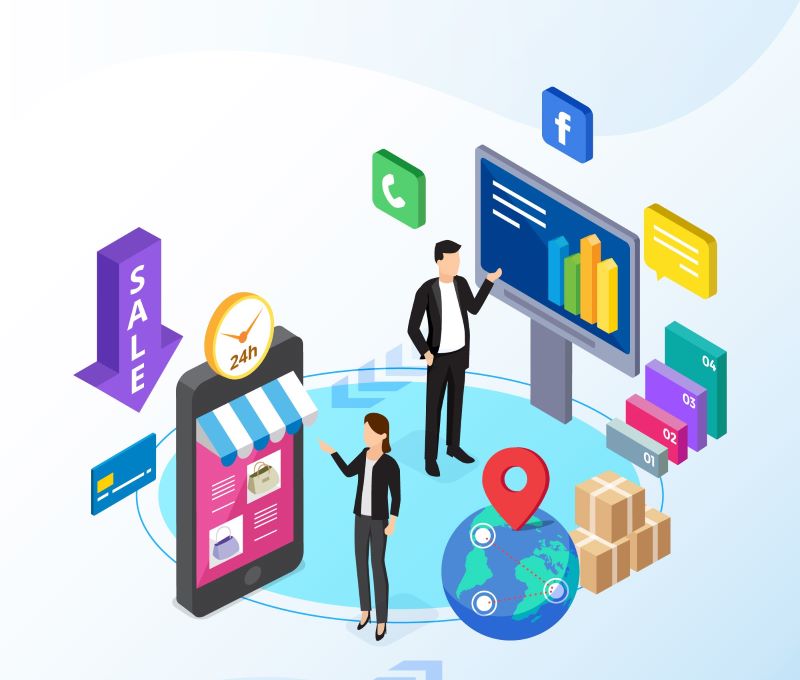Is Multichannel Retailing Only for Big Brands?
Driven by evolving customer needs and market dynamics, adaptation is not merely a choice but a necessity. Sales no longer follow a linear path. Instead, consumers increasingly prefer the convenience of online shopping from the comfort of their homes. While this is profitable from a business perspective, it’s not as simple as it sounds. With more avenues now available for customers, brands must go the extra mile to ensure these requirements are met and explore additional ways to retain them. Failure to do so risks losing ground to competitors who embrace the multi-channel retail strategy. This new shift in consumerism is what businesses refer to as a multi-channel retail strategy.
Multi-channel retailing is the first step towards transforming the business model, offering businesses multiple avenues to engage with their customers. This strategy empowers businesses to meet these expectations by establishing a presence across online platforms, brick-and-mortar stores, social media, mobile apps, and more.
Despite its numerous benefits, multichannel retailing is often misunderstood. One prevalent misconception is that it is an exclusive domain of large corporations with substantial resources. This notion stems from the perception that only big brands can afford the infrastructure and technology required to manage multiple channels effectively. In this blog, we aim to debunk this myth and shed light on the opportunities it presents for businesses of all sizes. By examining the fundamentals of multichannel retailing and its profitability for businesses of all scales, we aim to provide clarity and encourage broader adoption of this strategy.

Explore what exactly is multichannel retailing and how it is different from Omnichannel retailing
Dispelling the Myth
Addressing the Perception
Multichannel retailing is not a privilege reserved for big brands; rather, it is a strategic approach that can be tailored to suit businesses of any size. At its core, multichannel retailing involves diversifying sales channels to reach a broader audience and provide customers with more convenient shopping experiences. While large corporations may have more extensive resources at their disposal, the principles of multichannel retailing remain accessible to businesses of all scales.
How Does Multichannel Retailing Work?
Multichannel retailing involves selling on various channels like wholesale, retail, various ecommerce marketplaces and offline stores. These touchpoints are where customers can interact with a brand and make purchases. By leveraging these diverse channels, businesses can meet customers wherever they prefer to shop, whether online or offline, thereby maximizing their reach and revenue potential.
Multi-channel retailing seamlessly merges various platforms to form a dynamic hybrid environment. There are different options that retailers can choose and rely on. The underlying reason is to create a formidable market presence while effectively engaging with a diverse customer demographic. The activities involved in multi-channeling are an even mix of retailing and marketing. Implementing multi-channel strategies necessitates the seamless integration of industry best practices, cutting-edge methodologies, and the latest technological advancements.
How Profitable is Multichannel Retailing for Small or Medium-Sized Businesses?
Contrary to popular belief, multichannel retailing can be highly profitable for small and medium-sized businesses. While the initial setup costs and technological requirements may seem daunting, the long-term benefits far outweigh the investment. By diversifying their sales channels, SMBs can tap into new markets, attract different customer segments, and mitigate the risks associated with reliance on a single channel. Moreover, advancements in technology have made multichannel integration more accessible and cost-effective than ever before, leveling the playing field for businesses of all sizes.
With more than one way to push sales, multi-channel retailing is indeed a profitable strategy. To substantiate this assertion with empirical evidence, consider that customers engaged with a multichannel business:
- Spent 15–35% more in terms of transactions
- Demonstrated a 10% more loyalty to the brands
- And experienced up to 30% higher value when compared to single-channel businesses
These statistics unequivocally underscore that multichannel retailing is not a luxury reserved for big brands but a strategic imperative for businesses seeking to thrive in today's competitive landscape. By embracing this approach, businesses of all sizes can expand their reach, enhance customer experiences, and drive sustainable growth in the digital age. It's time to debunk the myth and seize the opportunities that await in the multichannel realm.
What are the Major Types of Multi-channel Retailing?
If a business wants to engage with the target audience and convert them into potential customers, they need to explore all possible retail channels. There are several types of multi-channel retailing, each with its unique characteristics and benefits. Here are the most common types of multi-channel retailing:
- Direct-to-consumer (D2C) store- As the name suggests, D2C is a type of retail model in which a manufacturer sells its products directly to customers. In a D2C store, the manufacturer owns and manages the entire sales process, from product development and production to marketing, sales, and customer service.
- Online store- Online stores, often referred to as 'brick-and-click' establishments, are platforms that seamlessly integrate traditional brick-and-mortar operations with a robust online presence. Online Store provides customers with the ease of browsing and buying from home while still offering in-person shopping options.
- Social media- This type of multi-channel retailing known as social commerce involves using social media platforms, such as Instagram, Facebook, YouTube, and Pinterest, to sell products directly to customers. It is an effective way to engage customers and build brand loyalty. Today, social media has become an integral part of the modern purchasing journeys driving the entire sales funnel.
- Online marketplaces- Global online marketplaces are another option to include in a multi-channel retailing strategy. Online marketplaces are e-commerce platforms where multiple sellers can offer their products and services for sale to a large pool of potential customers.
- Brick-and-mortar stores- Brick-and-mortar stores are the biggest evolution towards multi-channel retailing. Here customers can browse and purchase products in person. Brick-and-mortar stores can range in size from small boutiques to large department stores. They are a convenient way to reach local customers.
- Mobile commerce- With smartphones becoming a norm, it has become more than necessary for retailers to choose mobile commerce. Businesses need to build mobile-friendly websites and apps that can satisfy customer requirements via mobile on the go.
- Wholesale- Instead of selling the products directly to the target audience, businesses can adopt a wholesale approach to sell to other retailers in bulk. Businesses can easily do this with their physical/online store. Wholesale retailing is an essential part of the supply chain and allows for the efficient distribution of goods from manufacturers to retailers, and finally to consumers.
- Omnichannel- It is a strategy in multi-channel retailing that focuses on providing a seamless and integrated shopping experience to customers across all channels. This means that customers can interact with a retailer through various channels and receive a consistent and personalized experience. The focus is to create a consistent brand image and messaging across all channels.

Advantages of Multichannel Retailing
Here are some compelling benefits of embracing multichannel retailing:
- Increases Reach and Accessibility: By diversifying sales channels, the business can reach a wider audience. Online platforms and marketplaces enable businesses to tap into global markets and connect with customers who prefer shopping from the comfort of their homes.
- Gains a Competitive Edge: Multichannel retailing empowers brands to distinguish themselves by reaching customers on their preferred platforms and gaining a distinct competitive advantage. Making the products available on channels where the competitors aren’t selling can capture untapped market opportunities.
- Enhances Customer Experience: Multichannel retailing offers customers the convenience of choosing how they want to interact with the brand. Multichannel retailing provides multiple touchpoints, enhancing the overall shopping experience, and fostering customer loyalty.
- Leverages the Power of Marketplaces and Search Engines: Joining online marketplaces and optimizing for search engines can greatly boost a brand's visibility and discoverability. These platforms help retailers tap into existing audiences without starting from scratch. 65% of consumers surveyed by DigitalCommerce360 expressed confidence in purchasing from unfamiliar third-party sellers on marketplaces.
- Provides Flexibility and Adaptability: Multichannel retailing allows retailers to quickly adapt to constant changes by experimenting with different channels and adjusting strategies accordingly. This flexibility is crucial in staying relevant and competitive in today's dynamic retail landscape.
- Minimizes Costs and Maximizes ROI: Contrary to the misconception that multichannel retailing is only for big brands, this approach can be cost-effective for businesses of all sizes. Advancements in tech and logistics make it easier and more affordable to set up and manage multiple sales channels. Moreover, diversifying revenue streams can lead to a higher long-term ROI. As inventory grows, costs per product sold decrease for platform customization, marketing, etc.

Harness the potential of multichannel retailing
Practical Steps for Implementing Multichannel Retailing
Implementing multichannel retailing requires careful planning and execution. Here are some practical steps to help retailers successfully adopt this strategy:
- Assessing Business Needs and Goals: Start by evaluating the current business model, target audience, and long-term objectives. Identify the channels that align with brand identity and are most likely to resonate with the customers.
- Choosing the Right Channels: It's crucial to prioritize the channels that are most relevant to the audience. By considering channels that match businesses' products and target audiences, retailers can gain a competitive edge.
- Investing in Technology and Infrastructure: Implementing multichannel retailing requires investment in the right technology and infrastructure. This may include e-commerce platforms, inventory management systems, POS software, and CRM tools.
- Training and Empowering Staff: Employees play a critical role in delivering a consistent and exceptional customer experience across all channels. Train staff thoroughly to effectively manage sales channels and handle customer inquiries and concerns.
- Collecting Valuable Data on Customer Purchases: Implement systems to analyze customer purchases, preferences, and interactions across different channels. Use this data to personalize marketing efforts, improve inventory management, and enhance the shopping experience.

Adapt to evolving consumer needs with the best multi-channel retail solution
Key Challenges of Multichannel Retailing
Multichannel retailing brings with it a set of challenges that businesses of all sizes must navigate:
- Coordinating inventory across sales channels: Maintaining accurate inventory levels across multiple platforms can be complex and prone to errors without the right systems in place.
- Costly investments: Setting up and managing multiple sales channels requires financial investments in technology, infrastructure, and marketing efforts. This challenge is being solved by technology players through integrated offerings that do not require expensive integration costs and do not have long waiting times for the integration. This is where Ginesys One scores over other solutions.
- Selling on irrelevant channels: Not all channels may be suitable for every brand. Choosing the right mix of channels is crucial to avoid wasting resources on ineffective platforms.
- Setting up the infrastructure: From logistics to customer support, establishing the necessary infrastructure to support multichannel retail operations demands careful planning and execution.

Strategies for Overcoming Multichannel Retailing Challenges
While multichannel retailing challenges are significant, they are not insurmountable. From the above analysis, it is clear only the technology piece requires investment and if there is a suite available, this problem goes away. This is a key reason that many SMB brands have opted for the Ginesys One suite, giving them access to an all-in-one integrated solution with minimum waiting time and upfront investment. Here are some further strategies:
- Determine the sales channels to target: Conduct market research to identify which channels align best with the target audience and business objectives. The first and most important step is to prioritize the channels with the help of competitor analysis. This helps in understanding whether a particular channel is worth the investment in or not.
- Create a customer profile: Understanding customers' preferences, behaviors, and shopping habits to tailor the multichannel approach accordingly. The next step is to create a customer profile for every channel. Businesses should also create categories based on location, job, hobbies, etc. for better engagement.
- Set up goals and KPIs: Define clear objectives and KPIs to measure the success of multichannel strategy and adjust as needed. After defining sales channels and customer profiles, businesses can now move forward to setting up realistic goals. Identify the KPIs along with the qualitative and quantitative metrics that can help achieve the required objectives.
- Build a proficient team: Invest in skilled professionals who can manage and optimize each sales channel effectively, from inventory management to marketing campaigns. Depending on the number of targeted channels, hire the right talent. For instance, for online sales channels, hire social media professionals or partners along with a digital retail and e-commerce partner.
- Personalize conversations and build channel-specific assets: Tailor messaging and content to suit each channel's audience, ensuring a cohesive yet personalized experience. This step is all about conveying the right message to the target audience through a variety of marketing mediums like testimonials, landing pages, ads (display, video, magazine), and more.
- Harness the power of automation with the Ginesys One omnichannel suite or other similar technology suites: Leverage comprehensive solutions like Ginesys One, which includes a multichannel Order Management System (OMS) like Browntape, to streamline operations and improve efficiency. Use popular CRM and marketing tools integrated with Ginesys One to automate the process of gathering customer data from various channels.
- Track key metrics and results: Monitor performance metrics to identify areas of improvement and optimize the multichannel strategy for better outcomes. Closely monitor sales per channel alongside measuring incremental sales. Boost channels that are performing well and replace the poorly performing ones with alternative retail channels.
- Prioritize channels with utmost consistency: Divert efforts on the channels that yield the highest returns and maintain consistency in branding, messaging, and customer experience. After following these steps, businesses might discover that their efforts benefit one channel but disrupt others. In such cases, adjust the strategy for a consistent brand experience.

Unleash efficiency: Ginesys One automates omnichannel operations seamlessly
In exploring the landscape of multichannel retailing, the blog has debunked the myth that it's solely the domain of big brands with expansive budgets. From examining the benefits to understanding the challenges, it's evident that multichannel retailing is not only accessible but also advantageous for businesses of all sizes. Multichannel retailing allows businesses to tap into diverse revenue streams. So, whether it is a small boutique or a global conglomerate, now is the time to embrace the power of multichannel retailing and unlock the full potential of a business.
By leveraging the diverse channels served by Ginesys One, businesses can forge deeper connections with their audience while expanding their reach and revenue streams. By harnessing the power of Multichannel Retailing with the comprehensive solutions offered by Ginesys, businesses can position themselves at the forefront of innovation, securing a resilient future in the ever-evolving marketplace.

